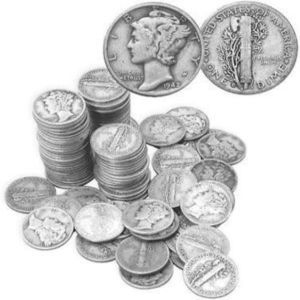Silver Dimes
90% Silver Dimes - Roosevelt Dimes & Mercury Dimes
Silver Dimes Quick Facts

The US Mint began issuing the modern dime in 1892. Up until 1964, all dimes in circulation were minted from 90% silver, which was customary for coinage of the era. During that timespan the US Mint produced three different common variations of ten cent coin.
- The Barber Dime, named after the designer, Charles Barber.
- The Mercury Dime, named from the depiction of Lady Liberty that looks similar to the Greek God Mercury.
- The Roosevelt Dime, created after the death of President Franklin D. Roosevelt.
90% silver dimes are a favorite of investors, silver stackers, preppers and coin collectors alike. Hundreds of millions of silver dimes were issued and used for the everyday purchases of normal Americans.
Each coin contains roughly .07 troy ounces of silver. Due to their fractional nature, dimes are an excellent choice for those prepping for a financial disaster or believe bartering could become more prevalent.
Silver stackers love silver dimes. Silver dimes are incredibly common. They are often available from online bullion dealers and local coin stores at the lowest premium over spot price. A $100 Face Value bag of silver dimes contains 1,000 individual coins.
Coin collectors and numismatists love silver dimes because there are so many unique varieties and variations. A complete set of Mercury Dimes that includes all mint marks and dates contains more than 70 coins. Die variations and error coins add even more to collect.
Various collector albums are available from Dansco and Whitman that provide a great way to learn about the history and all of the variations available in ten-cent coins while building a store of value.
Investors appreciate the simplicity of investing in 90% junk silver because it is a practical investment that is always in demand. With regard to premiums, 90% silver coins have appreciated a considerable amount in recent years and is now trading above spot silver price. 90% silver dimes remain one of the cheapest, low premium options when shopping for precious metals.
Rare Silver Dimes
Dimes with errors, such as double dies, planchet errors, or unique characteristics, some dimes from various years and mintmarks had remarkably low mintage figures, and over the years, many have been melted down contributing to their rarity and adding to their value.
- 1894-S Barber Dime - This is one of the key dates in the Barber Dime series. With only 24 known surviving examples, it has become one of the most rare and sought after silver dimes. It is also one of the most valuable, with one piece selling at auction in 2016 for nearly $2 million.
- 1916-D Mercury Dime - This dime is considered one of the most famous key dates in the Mercury Dime series. It's highly sought after by collectors, partly due to its low mintage. Even in worn or circulated condition, these dimes can sell for well over $1,000.
- 1921-D Mercury Dime - The 1921-D Mercury Dime is another key date in the series. It was struck for only a brief period and is rare, especially in higher grades.
- 1942 over 41 Mercury Dime Overdate - This variety of the 1942 Mercury Dime features a "2" over a "1" in the date. It's a well-known error and Uncirculated examples are quite valuable. Finding coins like this when searching through junk silver dimes is a lovely surprise.
- 1945 Micro S Mercury Dime - This variety of the 1945 Mercury Dime features a tiny "S" mintmark, making it distinct from the regular issue. It's a notable variety and with many authentic and graded examples in various conditions, this dime is accessible to many collectors.
Roosevelt Silver Dimes
The Roosevelt Dime is a ten-cent coin issued by the United States Mint. The coin was first minted in 1946, shortly after the death of President Franklin D. Roosevelt. The coin features a portrait of Roosevelt on the obverse side, while the reverse side depicts a torch in the center, with an olive branch on the left and an oak branch on the right. The design was intended to honor President Roosevelt's legacy, particularly his founding of the March of Dimes, a program that funded research to cure polio.
Due to rising silver prices, the mint changed the composition of the coins in 1965 and introduced the clad version of this coin that continues to circulate today. Despite this change in metal content, the design of the Roosevelt Dime has remained consistent over the years, making it one of the longest-running coin designs in U.S. history.
Mercury Silver Dimes
Despite its nickname, the coin does not depict the Roman messenger god Mercury, but rather a depiction of Liberty wearing a winged Phrygian cap, a design that was often confused with Mercury. This design was issued by the United States Mint from 1916 to 1945.
The obverse was struck with a design that features Liberty in a winged cap, symbolizing freedom of thought. The reverse of the coin features a fasces, representing unity and strength, and an olive branch, signifying peace.
The 90% Silver Mercury Dime was produced at three different mint locations, each of which has its own corresponding mint mark: Philadelphia, Denver (D) and San Francisco (S).
The Mercury dime remains a favorite among collectors for its unique design and silver content. Some of the most sought after Mercury dimes are the 1916-D, 1921, and 1921-D, due to their lower mintage numbers.
Barber Dimes
Designed by Chief Mint Engraver Charles Barber, the design was issued by the US Mint from 1892 until 1916. The front features a head-and-shoulders depiction of Lady Liberty, facing right while dressed in a Phrygian cap and laurel wreath. The coin is part of the "Barber Coinage," a series of coins that also included a quarter and half dollar featuring the same design
The Barber dime was minted at four different mints, with each location designated by the mintmark: Philadelphia (no mintmark), Denver (D), San Francisco (S), and New Orleans (O). Mintages of Barber silver dimes were inconsistent throughout the years and one of the rarest Barber dimes is the 1895-O, with a mintage of just 440,000 coins. On the other hand, the 1911 from the Philadelphia Mint had a mintage of over 18.8 million coins.
90% Silver Dimes
Dimes minted in the United States prior to 1965 were made of 90% silver. Each of these dimes contained approximately 0.0715 troy ounces of silver. So, $1 face value of pre-1965 U.S. dimes contains approximately 0.715 troy ounces of silver. It's worth noting that circulation can lead to minor variances in the weight due to wear and tear. These worth of these face value lots of silver dimes fluctuates based on current silver prices. Shop and compare to find which online bullion dealer has the cheapest price for 90% silver dimes.
Pre-1965 silver dimes can be considered a good store of value for investors looking for a low-cost investment. These dimes are composed of 90% silver and 10% copper. The intrinsic value of the silver content can make these coins a good hedge against inflation or economic uncertainty, as precious metals most often retain their value over time relative to economic conditions.
Older silver dimes, particularly those in good condition or with rare mints or other features of interest can also have numismatic value to collectors, adding to their worth above and beyond the raw silver value.
Because of their small size, silver dimes can be used to store a relatively small amount of wealth in physical form. This can be handy if you ever want to sell only a portion of your precious metals holdings, making them one of the most liquid physical assets.
90% Silver dimes are recognizable and accepted as holding intrinsic value enabling easier barter transactions in a crisis situation.
Frequently Asked Questions about Silver Dimes
- Question: What years of dimes are made from silver? - Answer: Silver Dimes were issued by the US Mint from 1892 until 1964.
- Question: How many dimes are there in a standard bank roll? - Answer: A standard bank roll of dimes, sometimes called a shotgun roll, contain 50 ten cent coins, providing a total face value of $5 USD with an approximate silver weight of roughly 3.575 troy ounces.
- Question: What are the different styles of silver dimes? - Answer: There were three distinct styles of silver dimes produced by the Mint, the Roosevelt Dime, the Mercury Dime, and the Barber Dime.
Where to find the cheapest Silver Dimes
FindBullionPrices.com compares prices from trusted and reputable online precious metals dealers to help you find the lowest premiums when shopping for Silver Dimes. The prices on our site are updated hourly and adjusted for silver spot price, providing a tool that helps investors compare silver prices.
We help find the cheapest Silver Dimes when you're ready to buy.
You can find a large assortment of silver coins at FindBullionPrices.com. If we don't list prices for something you're looking for Contact Us and let us know so we can add it.
Compare Silver Dimes prices
FindBullionPrices.com compares Silver Dimes prices from top-rated and trusted bullion dealers. Our product listings compare the online prices to help you buy the cheapest Silver Dimes.







